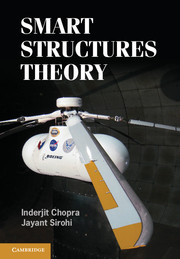Book contents
- Frontmatter
- Contents
- Preface
- 1 Historical Developments and Potential Applications: Smart Materials and Structures
- 2 Piezoelectric Actuators and Sensors
- 3 Shape Memory Alloys (SMAs)
- 4 Beam Modeling with Induced-Strain Actuation
- 5 Plate Modeling with Induced-Strain Actuation
- 6 Magnetostrictives and Electrostrictives
- 7 Electrorheological and Magnetorheological Fluids
- 8 Applications of Active Materials in Integrated Systems
- Index
- References
6 - Magnetostrictives and Electrostrictives
Published online by Cambridge University Press: 18 December 2013
- Frontmatter
- Contents
- Preface
- 1 Historical Developments and Potential Applications: Smart Materials and Structures
- 2 Piezoelectric Actuators and Sensors
- 3 Shape Memory Alloys (SMAs)
- 4 Beam Modeling with Induced-Strain Actuation
- 5 Plate Modeling with Induced-Strain Actuation
- 6 Magnetostrictives and Electrostrictives
- 7 Electrorheological and Magnetorheological Fluids
- 8 Applications of Active Materials in Integrated Systems
- Index
- References
Summary
Magnetostrictives and electrostrictives are active materials that exhibit magneto-mechanical and electromechanical coupling, respectively. These materials undergo a change in dimensions in response to an applied magnetic or electric field. A common property of both materials is that the induced strain depends only on the magnitude of the applied field and is independent of its polarity. In other words, it can be said that the induced strain has a quadratic dependence on the applied field. It is this behavior that differentiates electrostriction from the piezoelectric effect, which is also caused by an electric field. This chapter discusses the basic mechanisms behind magnetostriction and electrostriction, and it describes how these materials are used to construct practical actuators and sensors. The behavior of magnetic shape memory alloys (SMAs) is also described.
Magnetostriction
A ferromagnetic material placed in a magnetic field generally undergoes a change in shape [1]. The internal structure of a ferromagnetic material consists of randomly oriented magnetic domains. When a magnetic field is applied, the domains rotate to align themselves along the field, causing a change in the material dimensions. This phenomenon is known as “magnetostriction.” The effect is small in most materials but is measurable (on the order of microstrain) in ferromagnetic materials. Some materials, such as Terfenol-D, exhibit magnetostrictive strains on the order of 2000 microstrain (2000 × 10×6). Such materials can be used as both solid-state actuators and magnetic-field sensors. Magnetostrictive materials are available in the form of rods, thin films, and powder.
Information
- Type
- Chapter
- Information
- Smart Structures Theory , pp. 581 - 684Publisher: Cambridge University PressPrint publication year: 2013
References
Accessibility standard: Unknown
Why this information is here
This section outlines the accessibility features of this content - including support for screen readers, full keyboard navigation and high-contrast display options. This may not be relevant for you.Accessibility Information
- 1
- Cited by
